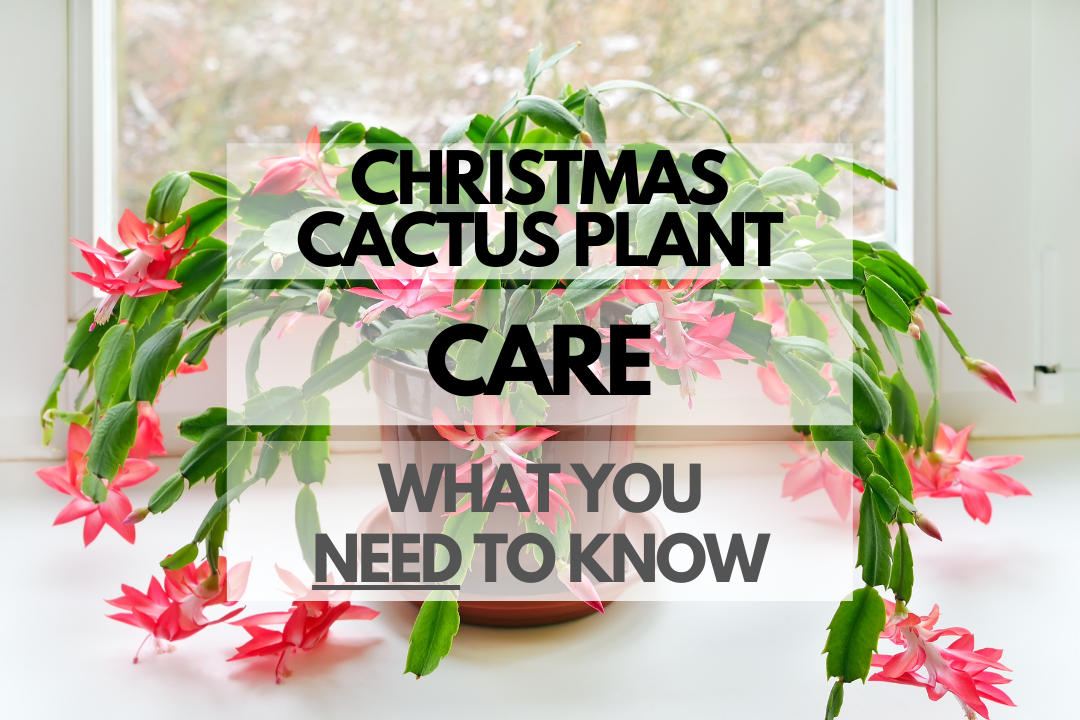Christmas Cactus Plants, known for their colorful, festive blooms, are a popular choice for holiday decorating and year-round enjoyment. These unique, easy-to-care-for plants can thrive indoors with minimal attention, making them perfect for busy plant parents or those new to gardening. In this guide, we’ll cover everything you need to know about Christmas Cactus Plant care, from sunlight and soil preferences to watering, pruning, and common problems.
Christmas Cactus Plant Care Guide
Quick Reference Table: Caring for Christmas Cactus Plant
| Aspect | Details |
|---|---|
| Sunlight | Bright, indirect light |
| Soil | Well-draining soil mix with added perlite or sand |
| Watering | Allow top inch of soil to dry between waterings |
| Pruning | After blooming, remove spent flowers and trim overgrown segments |
| Temperature | 65-75°F (18-24°C) during the day; 55-65°F (13-18°C) at night during blooming |
| Problems | Bud drop, root rot, pests |
| Indoor/Outdoor | Indoors year-round; outdoors in summer if protected from direct sun and harsh weather |
Christmas Cactus Plant Sunlight: Do They Need It and How Much?
Christmas Cactus Plants prefer bright, indirect light. Direct sunlight can cause the leaves to become scorched, so it’s important to place your plant near a window with filtered light or in a spot that receives gentle morning or late afternoon sun. Too little light can result in weak growth and fewer blooms.
Christmas Cactus Plant Soil Tips
These plants require well-draining soil to prevent root rot. A high-quality potting mix with added perlite or sand will ensure proper drainage. You can also use a soil mix specifically designed for cacti and succulents. Make sure to choose a pot with drainage holes to allow excess water to escape.
Christmas Cactus Plant Watering and Frequency
Water your Christmas Cactus Plant when the top inch of soil feels dry to the touch. Overwatering can lead to root rot, so it’s important to let the soil dry out slightly between waterings. During the blooming period, you may need to water more frequently to keep the soil evenly moist. Reduce watering in the winter months when the plant is dormant.
Pruning Christmas Cactus Plant Properly
Prune your Christmas Cactus Plant after it finishes blooming by removing spent flowers and trimming overgrown or tangled segments. This will encourage healthy growth and help maintain the plant’s shape. To prune, simply pinch or use a clean, sharp pair of scissors to remove the desired segment.
Optimal Christmas Cactus Plant Temperature: Can They Tolerate the Cold?
Christmas Cactus Plants prefer temperatures between 65-75°F (18-24°C) during the day and slightly cooler temperatures of 55-65°F (13-18°C) at night during the blooming period. They can tolerate temperatures as low as 50°F (10°C) for short periods but should be protected from frost and extreme cold, as this can cause damage or even kill the plant.
Common Christmas Cactus Plant Problems
Bud Drop
Bud drop can occur when the plant is exposed to sudden temperature changes, drafts, or overwatering. To prevent bud drop, keep your Christmas Cactus Plant in a stable environment with consistent temperatures and avoid overwatering.
Root Rot
Root rot is caused by overwatering or poor drainage. To prevent this issue, use a well-draining soil mix and water only when the top inch of soil is dry. Ensure your pot has drainage holes to allow excess moisture to escape.
Pests
Christmas Cactus Plants can be susceptibleto pests like mealybugs, spider mites, and scale insects. Inspect your plant regularly for signs of infestation, and treat with insecticidal soap or neem oil if necessary. Keeping your plant healthy and stress-free can also help prevent pest problems.
Christmas Cactus Plant Outdoors vs Indoors
Christmas Cactus Plants can be grown both indoors and outdoors, though they are primarily grown as indoor plants due to their sensitivity to cold temperatures and direct sunlight. If you choose to grow your plant outdoors during the warmer months, be sure to provide protection from direct sun and harsh weather. Bring your plant indoors when temperatures start to drop in the fall.
| Pros | Cons |
|---|---|
| Growing Indoors | Growing Outdoors |
| Easy to control temperature and humidity | Requires careful monitoring of sunlight and temperature |
| Safe from harsh weather conditions | Can be damaged by extreme heat, cold, or wind |
| Less susceptible to pests | More exposed to pests and diseases |
| Year-round enjoyment | Must be brought indoors during colder months |
Best Pots for Christmas Cactus Plant
The best pots for Christmas Cactus Plants are ones that provide proper drainage and adequate space for the root system to grow. Choose a pot with drainage holes and a well-draining soil mix to prevent waterlogged roots. A shallow, wide pot is ideal, as these plants have a relatively shallow root system. Terra cotta pots are a popular choice because they help regulate moisture levels and provide a stable environment for the plant.
Christmas Cactus Plant Facts
Christmas Cactus Plant Benefits
- Air Purifying: Christmas Cactus Plants are known to help purify the air by removing some indoor air pollutants, such as formaldehyde.
- Low Maintenance: These plants require minimal care, making them perfect for busy plant parents or beginners.
- Attractive Blooms: Christmas Cactus Plants produce vibrant, colorful blooms during the holiday season, adding a festive touch to your home decor.
- Long-lived: With proper care, Christmas Cactus Plants can live for many years, providing long-lasting enjoyment.
- Adaptable: They can adapt to various indoor conditions, making them suitable for a wide range of environments.
Growth Rates: How Fast Do They Grow?
Christmas Cactus Plants typically grow at a moderate rate, with most plants reaching maturity in 3 to 5 years. Growth rates can vary depending on factors such as light, temperature, and overall plant health.
Christmas Cactus Plant Lifespan
With proper care, Christmas Cactus Plants can live for several decades. Some plants have even been known to live for over 50 years!
Are Christmas Cactus Plants Safe?
Christmas Cactus Plants are considered non-toxic to humans and pets, making them a safe choice for households with children, cats, and dogs.
Christmas Cactus Plant Flowers
These plants produce beautiful, tubular flowers that come in a variety of colors, including red, pink, white, and orange. Blooms typically appear in late fall or early winter and can last for several weeks.
Christmas Cactus Plant Types and Varieties
There are several different types of Christmas Cactus Plants, each with their own unique characteristics:
Schlumbergera truncata
This is the most common type of Christmas Cactus Plant, featuring segmented, flat leaves and vibrant blooms in shades of red, pink, and white.
Schlumbergera russelliana
Also known as the Thanksgiving Cactus, this variety has slightly more rounded leaf segments and produces pink or white flowers earlier in the fall season.
Schlumbergera x buckleyi
A hybrid of Schlumbergera truncata and Schlumbergera russelliana, this variety is known for its striking, bi-colored blooms in shades of pink and white.
Christmas Cactus Plant Pros and Cons
| Pros | Cons |
|---|---|
| Easy to care for | Sensitive to overwatering |
| Non-toxic to humans and pets | Requires a specific light and temperature regimen for optimal blooming |
| Attractive, colorful blooms | Prone to bud drop if not properly cared for |
| Long-lived | Can be susceptible to pests |
Christmas Cactus Plant Cost
Christmas Cactus Plants are generally affordable, with small plants typically costing between $10 and $20. Larger, more mature plants can cost upwards of $30 to $50, depending on the size and variety.
Where to Buy Christmas Cactus Plant
Christmas Cactus Plants can be found at most local nurseries and garden centers, as well as online retailers. Specialty succulent and cactus shops may also carry a wider selection of varieties and sizes.
Is Christmas Cactus Plant Propagation in Water Possible?
Yes, Christmas Cactus Plant propagation in water is possible. To propagate, simply remove a healthy segment from the plant, allow it to callous over for a day or two, and then place the cut end in a jar of water. After a few weeks, roots should begin to form, at which point the cutting can be transferred to soil.
Additional Resources
- ASPCA – Christmas Cactus Plant Toxicity
- Gardeners’ World – How to Grow Christmas Cactus Plant
- Facebook Group – Christmas Cactus Lovers
- Houzz Forum – Christmas Cactus Plant Care
- Book – The Complete Guide to Cacti & Succulents
FAQ for Christmas Cactus Plant Care
Are Christmas Cactus Plants toxic to cats?
No, Christmas Cactus Plants are considered non-toxic to cats.
Are Christmas Cactus Plants toxic to dogs?
No, Christmas Cactus Plants are considered non-toxic to dogs.
Are Christmas Cactus Plants toxic to kids?
No, Christmas Cactus Plants are considered non-toxic to humans, including children.
How tall do Christmas Cactus Plants get?
Christmas Cactus Plants typically grow to be about 12 to 24 inches tall, with a similar width.
Can Christmas Cactus Plants live outside?
Christmas Cactus Plants can be grown outside in regions with mild climates, provided they are protected from direct sunlight and extreme temperatures. In colder climates, they should be brought indoors during the winter months.
Are Christmas Cactus Plants poisonous?
No, Christmas Cactus Plants are not poisonous and are considered safe for both humans and pets.
How often should I water my Christmas Cactus Plant?
Water your Christmas Cactus Plant when the top inch of soil feels dry. Be careful not to overwater, as this can lead to root rot and other issues. During the growing season, they may need watering every 1-2 weeks, while in the winter, this may decrease to every 3-4 weeks.

